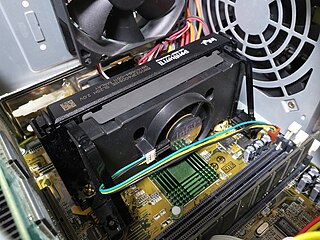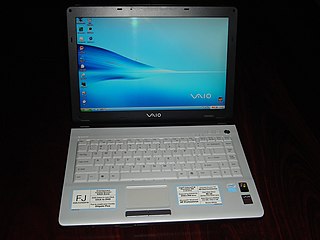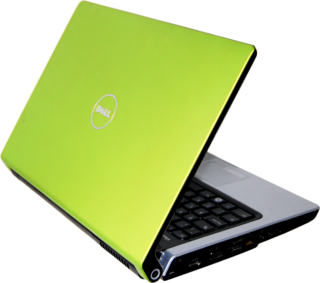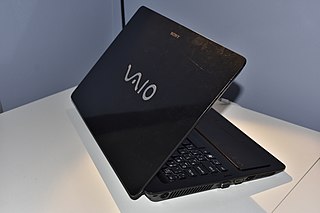
Celeron is a semi-discontinued series of low-end IA-32 and x86-64 computer microprocessor models targeted at low-cost personal computers, manufactured by Intel. The first Celeron-branded CPU was introduced on April 15, 1998, and was based on the Pentium II.

The Pentium II brand refers to Intel's sixth-generation microarchitecture ("P6") and x86-compatible microprocessors introduced on May 7, 1997. Containing 7.5 million transistors, the Pentium II featured an improved version of the first P6-generation core of the Pentium Pro, which contained 5.5 million transistors. However, its L2 cache subsystem was a downgrade when compared to the Pentium Pros. It is a single-core microprocessor.

Slot 1 refers to the physical and electrical specification for the connector used by some of Intel's microprocessors, including the Pentium Pro, Celeron, Pentium II and the Pentium III. Both single and dual processor configurations were implemented.
The Sony U series of subnotebook computers refers to two series of Sony products the PCG-U and the VGN-U. The later VGN-U were, at their release, the smallest independent computers running Windows XP and the most powerful high-end subnotebooks at the time. The VGN-U50 and VGN-U70P models are roughly the size of two DVD cases stacked on top of each other.

Pentium is a semi-discontinued series of x86 architecture-compatible microprocessors produced by Intel. The original Pentium was first released on March 22, 1993. The name "Pentium" is originally derived from the Greek word pente (πεντε), meaning "five", a reference to the prior numeric naming convention of Intel's 80x86 processors (8086–80486), with the Latin ending -ium since the processor would otherwise have been named 80586 using that convention.

The Compaq Presario 1200 was a line of notebook computers produced between 1998 and 2000 by Compaq as part of Compaq Presario line.

The Sony Vaio FJ series is a 14.1-inch notebook designed for Windows XP and the FJ270, FJ290, FJ330,FJ370 models in particular, are designed for Windows Vista. The FJ Series uses only the Pentium M processors using the Sonoma platform of Intel Centrino.

The IBM ThinkPad 380 was a notebook computer series released May 13, 1997 by IBM as part of their ThinkPad laptop series. Notable for incorporating a CD-ROM and a floppy drive, it was considered a mid-range laptop by IBM at the time, and sold well. The series was the successor to the IBM ThinkPad 365.

Dell Vostro is a line of business-oriented laptop and desktop computers manufactured by Dell aimed at small to medium range businesses. From 2013–2015, the line was temporarily discontinued on some Dell websites but continued to be offered in other markets, such as Malaysia and India.

Dell's Studio brand is a range of laptops and desktops targeted at the mainstream consumer market. The computers sit above Dell's Inspiron and below the XPS consumer lines in terms of price and specifications. They differ from Dell's lower-end Inspiron models by offering slot-loading optical drives, media keys, more cover design options, faster processor options, HDMI and eSATA ports, LED-backlit screens, and backlit keyboards.

IBM ThinkPad 760 was a notebook computer introduced in 1995 by the IBM corporation into the market as part of the ThinkPad 700-series. It was succeeded in 1998 by the ThinkPad 770 series.

The Vaio C1 PictureBook was a series of subnotebooks from Sony's Vaio lineup, branded 'PictureBook' for its webcam and video capture capabilities, a first for portable computers. PictureBooks were lightweight computers, weighing 1kg. They featured 8.9" LCD displays, and were notable for being the first consumer laptop with a built-in webcam.
The Sony Vaio 700 series were Sony's first Vaio branded laptops, starting with the 705 and 707 models, launched in Japan on July 1, 1997, and subsequently in the United States.
The Sony Vaio 800 series was a range of Vaio laptops launched in 1998. It was produced until early 1999.

The Vaio F series is Sony's multimedia and gaming orientated laptop series. Launched in January 2010, it replaced the Sony Vaio FW series. Like the preceding model, it features a 16.4" screen, but with Full HD 1920 x 1080 resolution, 240 Hz refresh rate, and LED backlight. The model came in two choices (VPCF2), 2D or 3D models. The 3D model is included with 3D glasses.
The Sony Vaio G series was a range of ultraportable subnotebook computers launched in 2007 with a 12.1" display.

The IdeaPad S Series is a series of notebook computers launched by Lenovo in October 2008. The IdeaPad S10 was initially scheduled for launch in September, but its release was delayed in the United States until October.

The Dell Inspiron series is a line of laptop computers made by American company Dell under the Dell Inspiron branding. The first Inspiron laptop model was introduced before 1999. Unlike the Dell Latitude line, which is aimed mostly at business/enterprise markets, Inspiron is a consumer-oriented line, often marketed towards individual customers as computers for everyday use.
Armada is a discontinued line of business laptops by Compaq. They started as a more affordable version of the Contura line, but after that, they replaced Contura as a mainstream laptop line, and then the high-end Compaq LTE line were merged with Armada as a premium 7300 and 7700 sub-lines.














